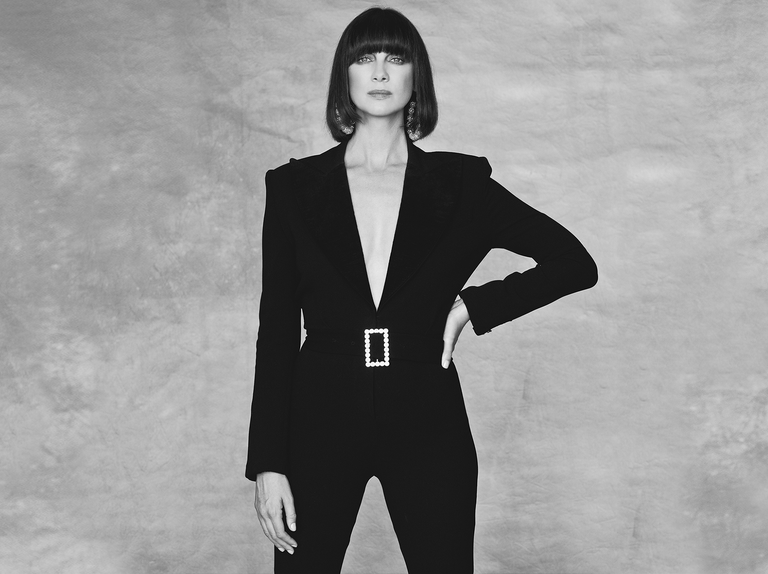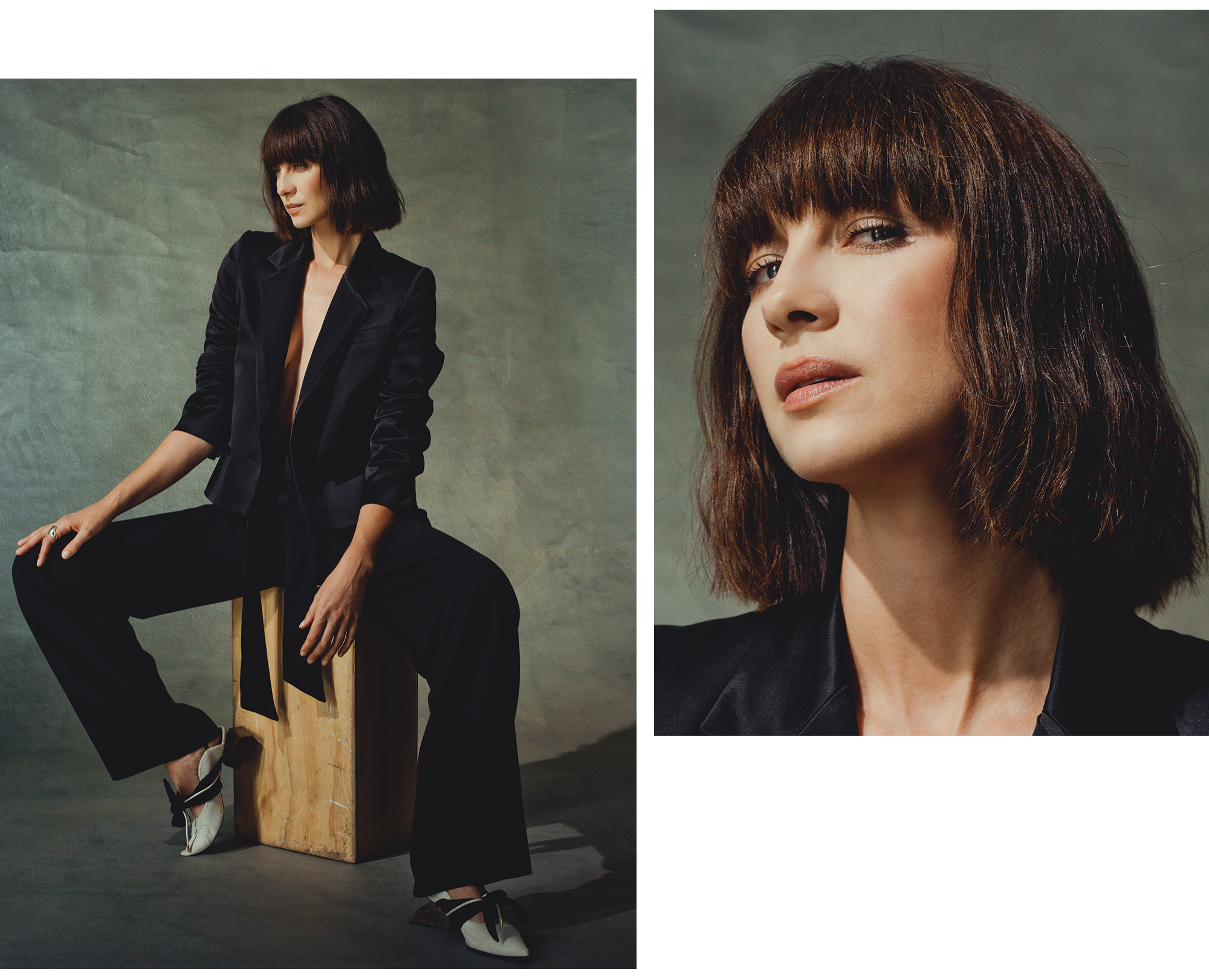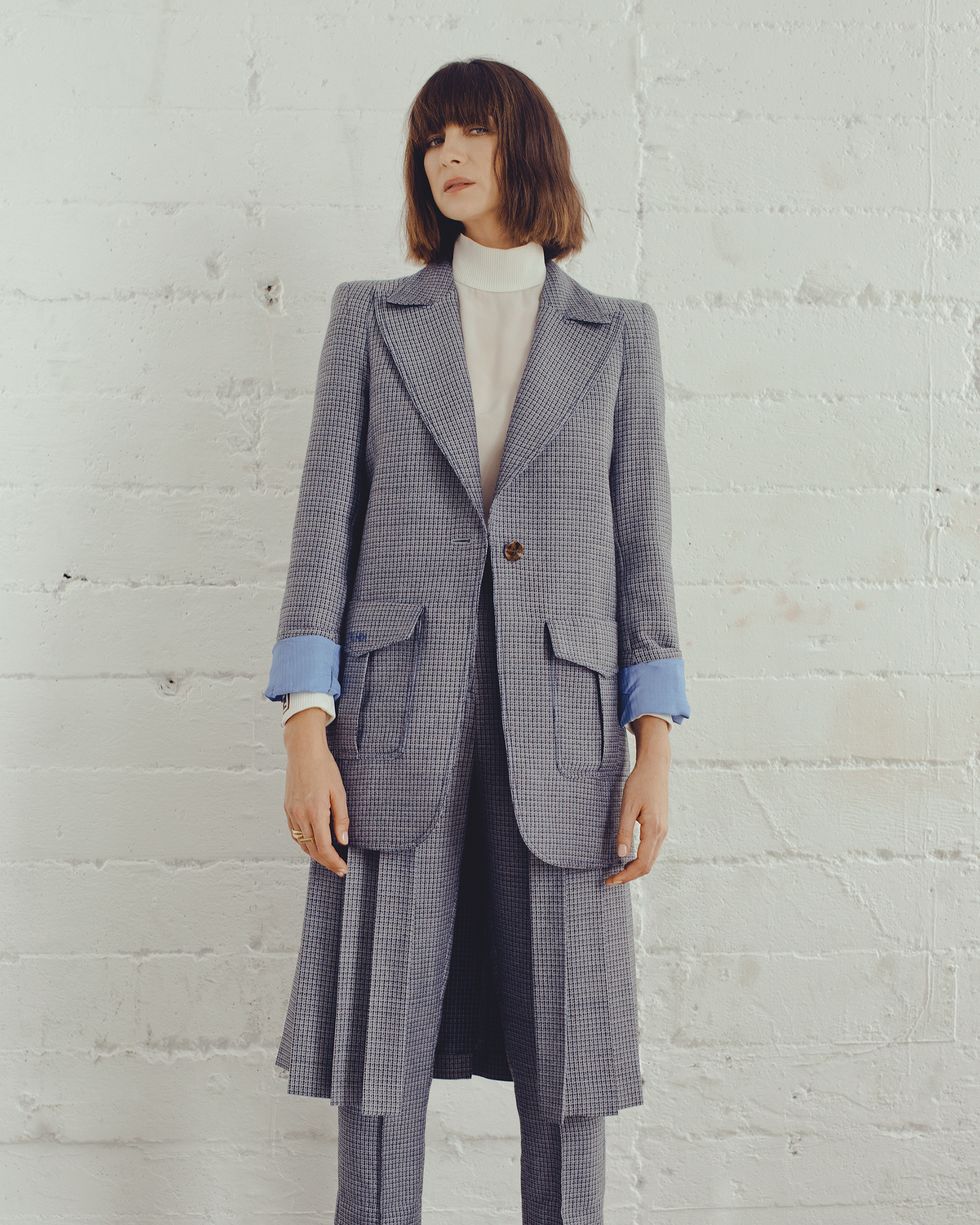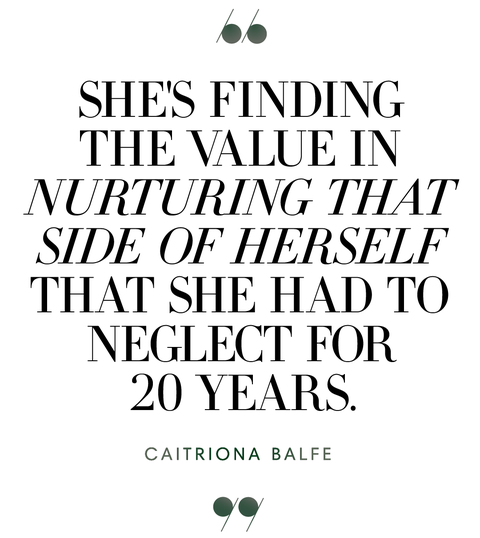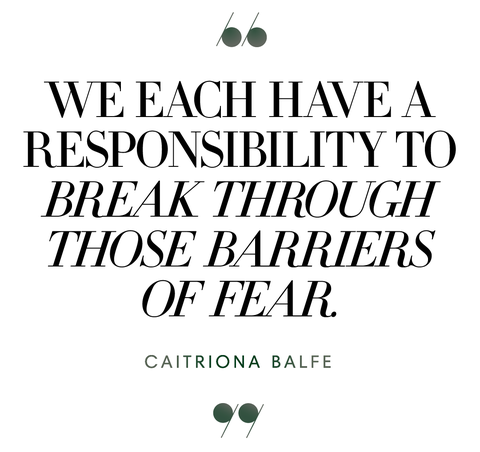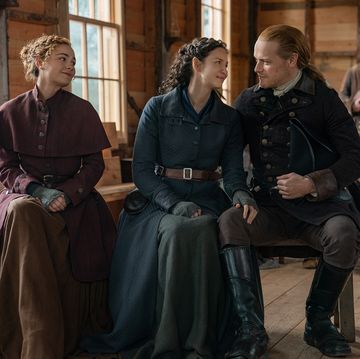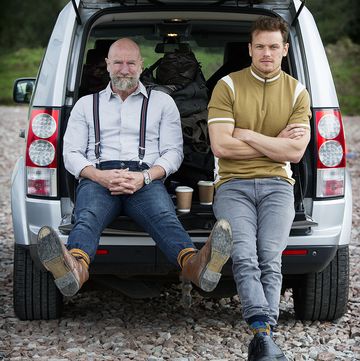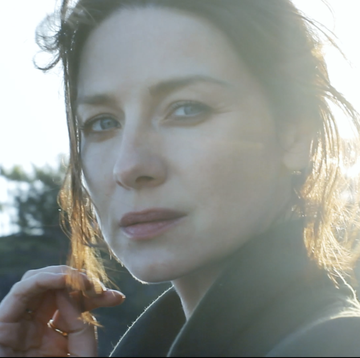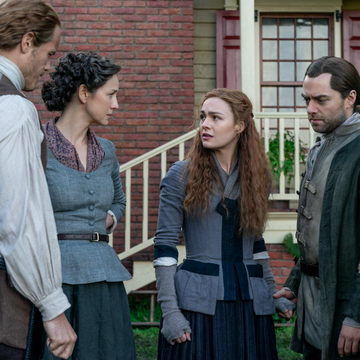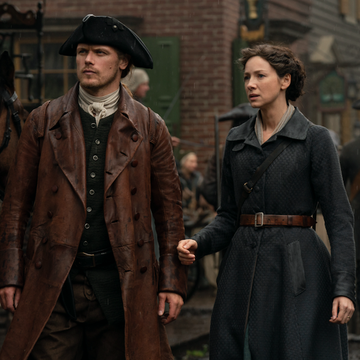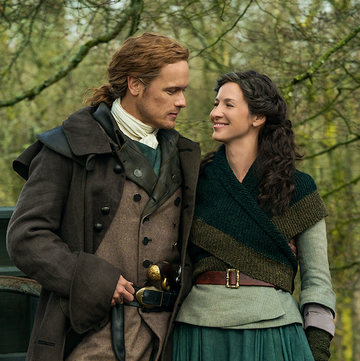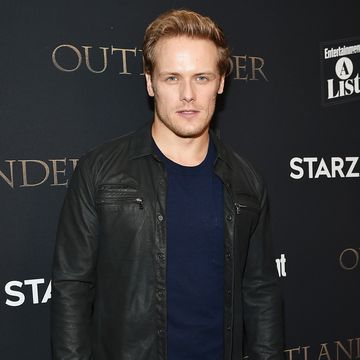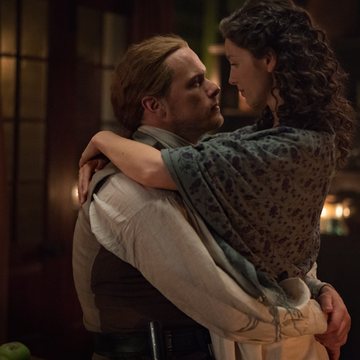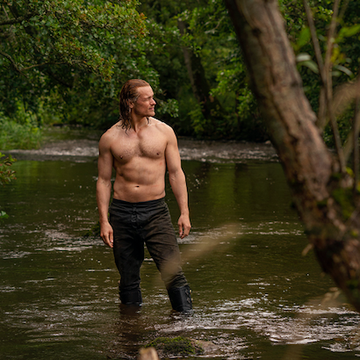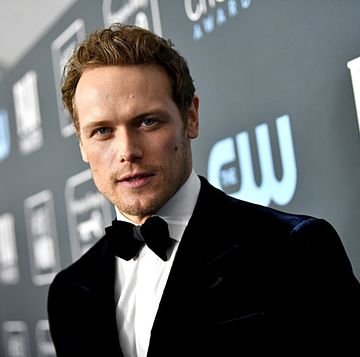On December 30, 1996, Delacorte Press released Drums of Autumn, the fourth book in Diana Gabaldon’s stealth blockbuster Outlander series. Tonight, 22 years to the day of publication, the most anticipated, beloved, compelling, and frustrating scenes in that book come to life on the series’ wildly popular TV adaptation. Though the episode revolves around the shaky dynamic between a young woman and the father she’s never met, it’s the mother, Claire Fraser, and the woman who plays her, Caitriona Balfe—the series’ linchpin, the gravitational force keeping the Outlander world on track and viewers coming back for 51 episodes and counting—who quietly shapes the hour.
Titled “The Birds and the Bees,” the episode focuses on 20th century-born Brianna Randall Fraser (Sophie Skelton) tracking down her mother Claire (Balfe) and father Jamie (Sam Heughan) in 1769 North Carolina. A thorny communion plays out between the stubborn, 1970s-shaped American and the Scottish Highlander father she's meeting for the first time. Confused? Welcome to the world of Outlander, in which a certain subset of the population can travel through time with the help of specific prehistoric monuments. More on that in a bit.
Above: Jumpsuit and earrings, Tom Ford. Below: Suit, Nina Ricci; Shoes, Prabal Gurung; Ring, Vintage Georg Jensen Nanna Ditzel Ring from Beladora.
This is what fans who devour Gabaldon’s books and track cast members’ every move (a fandom the New York Times describes as “one of television’s most passionate fan bases”) have waited more than two decades for: Claire and Jamie, the textbook “perfect couple,” reunited with their long-lost daughter to complete the Fraser family unit. “When Brianna comes back, you see Claire look around the table like, Oh my God. I’ve finally been able to have it all,” Balfe explains over the phone from LA after a dizzying month spent promoting Outlander's fourth season.
It’s an image Claire never allowed herself to imagine, and the road to this moment is paved with three-and-a-half seasons’ worth of timeline-hopping and tangled family trees. To quickly recap: In 1946, Claire, an English World War II nurse, accidentally travels to 1743 through a group of mystical standing stones in the Scottish Highlands. Though married in her own time, Claire weds a Highlander, Jamie Fraser, for protection, and they fall in love. Two years and a half-dozen life-threatening adventures later, Claire returns to the 20th century pregnant with Brianna. She's fleeing the aftermath of the Battle of Culloden, the Scottish conflict with the British that spells the end of Highland culture—and where Jamie plans to die alongside his comrades.
Claire spends the next 20 years in the 1950s and ‘60s, mourning Jamie and raising her daughter with her first husband, Frank. After his death, Claire and Brianna, with the help of an old friend (and Bree’s future romantic interest), historian Roger Wakefield, learn Jamie survived Culloden, and Bree urges Claire to return to her husband in the past. As Season 4 opens, the Frasers are happily reunited and settling into life in America in 1767. Meanwhile, Brianna, essentially orphaned in the 1970s, discovers a clue in historical documents that points to Jamie and Claire’s deaths, and decides to makes the dangerous journey through the stones to warn them. (When Roger discovers where Bree has gone, he, of course, follows her.)
Though the burgeoning relationship between Brianna and Jamie—complicated by two centuries’ worth of baggage, including the shadow of another father figure—is the subject of this episode, there’s something goosebump-inducing about Claire and Bree’s reunion. Claire—who has experienced several lifetimes’ worth of upheaval and should, at this point, be physically incapable of shock—is well and truly stunned. Though Gabaldon wrote Claire as a character whose face betrays her every emotion, Balfe always played the part at a slight remove, with an aloof dignity betrayed only when Claire decides to speak her mind. Yet in this scene, there’s no pretense, no emotional barrier—just poignant relief. It’s incredibly moving, compounded by Skelton nearly knocking Balfe off her feet in an embrace. (“Everything in one moment is in that hug she gives her Mom,” Skelton says. “I ran to her and threw myself on her, like Bree would do, but I think Cait nearly fell over.”)
It is, perhaps, the first truly uninhibited interaction between these characters. Their relationship in the 20th century was strained at best, the truth about Brianna’s real father stretching the chasm between daughter and workaholic mother nearly beyond repair. It took what both assumed would be a permanent separation to bring them closer than ever, and their reunion closes the last remnants of that gap. “It’s really Claire and Brianna meeting each other on equal footing,” Balfe explains. “This is woman to woman, whereas at the end of Season 2 she was still trying to raise a child—you're still very much trying to guide them, trying to teach them and tell them. When you're a mother to an adult, there is that friendship that comes into it. [Claire] knows she can't dictate to her anymore or tell her how to live her life. She sees she's this full woman who still needs nurturing and comfort from her mother, but at the same point, Brianna is a woman now. And I think Claire recognizes that.”
Suit and sweater, Fendi; Rings, Melinda Maria and stylist's own.
The seasons’ earlier episodes establish Jamie and Claire in a home to which they can actually welcome Brianna, with the couple making the decision to actually sit still for once. They buy a tract of land in the backwoods of North Carolina and establish Fraser’s Ridge, a homestead where Jamie can farm while Claire practices her medicine. “It is so nice to see this couple be settled… There's a solid foundation that Jamie and Claire have built, not only in their relationship, but now in this family, in this community,” Balfe says. “There's a contentment and a settled nature that we've never got to explore before.” While earlier seasons saw Jamie and Claire crisscross the Highlands and portions of mainland Europe before their separation in Season 3, Season 4 allows the couple to settle down—and, of course, engage in that intimacy fans come to expect and crave. “Season 1 and Season 2, Claire was in constant reaction to events happening around her, and then last season it was that investment in her professional life and daughter, but at the expense of a personal fulfillment in that kind of intimate way,” Balfe says. “This season, it was about self-nurturing, where it’s never really been about that before.”
Balfe admits she struggled with Claire, a woman equally as proficient wielding a knife against leering miscreants as she is a scalpel in an operating theater, settling into the role of homemaker. “I think we can all fall into traps in our own lives and in ourselves, and as an actor you can fall into traps with characters where you're like, Oh no, this is who they are and this is the way I see them. When I read those first scripts, it took me a second understand the shift. But I think that's what's so exciting about being on a show like this—[it] keeps you on your toes and keeps you challenged every season,” she says. “It's finding the value in what you're being given to explore in that particular moment. This season, she's finding the value in nurturing that side of herself that she had to neglect for 20 years… This is the first season where we see all the parts of her come together in a more cohesive way.”
In “The Birds and the Bees,” it’s Balfe’s performance as both mediator and a mother grappling with a shifting family dynamic—which quickly devolves into concern for her daughter’s welfare—that reminds viewers why Claire is the core of the show. Despite this portrait of a happy family, viewers know there’s heartache to come for the Frasers. What should be a celebratory occasion for Brianna is marred by the impact of last week’s episode, which saw her raped at the hands of a pirate, Stephen Bonnet, with fateful ties to her parents. Bonnet stole Claire’s wedding ring in the Season 4 premiere, and when Brianna met him in last week’s episode and attempted to pay for the ring’s return, the pirate attacked her. Skelton gives a standout performance as a young woman stunned by grief, and when Bree finally tells her mother about what she’s been through, the four-minute scene is cathartic for both viewer and audience. “This whole storyline was so harrowing,” says Balfe. “The thing that's so insidious about sexual assault is what a toll it takes on every relationship in the person's life.”
Balfe and Skelton’s performances are chilling, and the rapport between the actors underlines a real camaraderie. “You get very generous actors [on this show] and Caitriona is very much one of those,” Skelton says. “Even when it's not her take, she gives a 100 percent performance for you to feed off. She doesn't tire for you. If she's crying on her take, she'll cry on your take because you’re reacting to the same thing. Not a lot of actors are like that.”
It’s a performance that calls back to some of the best Balfe has given on the show—think her steely conviction in the face of Season 1’s general confusion, or the aftermath of her first daughter’s stillbirth in Season 2’s “Faith.” It’s easy to see why she’s received four consecutive Golden Globe nominations for her efforts. (Her most recent, for the current season, pends next Sunday’s awards ceremony.) Her energy and tenacity has been one of the series’ most compelling factors since its premiere in 2014—not to mention her chemistry with leading man Heughan and their smoldering sex scenes, the appeal of which lies in the show’s inherent female gaze. “Somehow this show was groundbreaking in the beginning because the female character was more fully fleshed out than we'd ever seen when you're telling these relationships,” Balfe recalls fondly. “We get to see sex through her eyes, we get to see all these things through her eyes. It's quite shocking that in 2014 that was somewhat slightly revolutionary. I know we weren't the only show doing it, but we were one of the only."
Hat and jacket, Saint Laurent.
Tonight’s episode explores some of the darkest material ever depicted on the show, but Balfe has always elevated material that could sink into soap opera territory, bringing depth, nuance, and gravitas to every scene. Claire’s reaction to Brianna’s news is a foil to her grief after Faith’s death; Claire can’t give herself fully to her rage because she has to have strength for her suffering daughter. “For Claire as a mother to know that in some way her actions… Claire can't help but take on the guilt of it in many ways, and the pain that she can't fix this, that she can't make it right," Balfe says. "That must be every mother's worst nightmare, when something happens to your child, that you can't protect them from it.”
Outlander has seen multiple main and supporting characters experience rape in past seasons, with critics and fans alike criticizing the show and its source material for its use of sexual violence as a plot device. Brianna’s assault in last week’s episode met mixed reviews, with some praising the decision to close the doors on the act itself, while others questioned the need to include the rape at all. “It's important to discuss these kind of things and explore them, because unfortunately they're all too real in our world,” Balfe says of the plot line. “We do straddle this tough line because we’re following a path that has been laid out in the books, and it's set in a time period where sexual assault was a weapon used freely and still is in many places today. We have to tell these storylines because they are an integral part to the overall story. But there's a concerted effort made on behalf of the writers and the producers and us actors that, if we're going to do it, then let’s find the best way of doing it.”
Balfe also sees this storyline as a chance to convey a vital truth: “The shame of sexual assault does not lie with the victims. I think that that's the most important message, especially in this episode—we don't get to shame victims. And that would have been such a commonplace reaction in that time. It's nice to see how Claire, especially when she's telling Jamie, how that conversation is guided to go in the complete opposite way.”
The episode ends on a cliffhanger, with Jamie beating Brianna’s partner Roger (remember him?) close to death after Bree’s traveling companion Lizzie mistakenly identifies him as Bree’s rapist. The rest of the season will deal with the aftermath of this monumental misunderstanding as well as Brianna’s pregnancy (she doesn’t yet know whether the baby is Roger’s or Bonnet’s). So yes, things are about to get a lot messier. And as the final four episodes explore these converging storylines, it’s impossible to miss an inevitable shift in the show’s storytelling methods. Throughout Season 4, Outlander has slowly splintered away from a razor-sharp focus on Claire and Jamie to make room for Brianna and Roger—an expansion from the original duo to a quartet. “The story is as much Brianna and Roger's as it is Claire and Jamie's,” Balfe says. “The show has evolved to tell the story of this couple, and more, this family.”
This season also marked the first with an episode in which neither Balfe nor Heughan appear. “We were so happy. We were like, yay! A break!” Balfe says, laughing. She recounts the grueling shooting schedules of the shows’ first seasons, the “11-day fortnights” which constituted shooting a six-day and a five-day week back-to-back. “There's an exhaustion level that kicks in,” she says. “I think all actors will tell you when you're in production like that, it's like you step outside the real world and you live in this bubble. You can do that for a certain amount of time, happily so, but then a couple years down the line you realize that real life is knocking at the door and demanding to be addressed.”
Balfe is excited about the opportunities this shift will afford her—in fact, she’s hoping to get to know Claire better. “Going forward it's going to be a much more evenly doled-out set of storylines. I will get my moments to really delve deep into Claire, but there will also be moments where I will have to take a step aside and let one of the other characters do that,” she says. She recalls Tobias Menzies’ method in Season 1: “[He] would come in and he'd have had two, three weeks off, and he would have taken his character and looked at it from seven, eight different points of view. His way of working was incredible. I think the one thing this is affording me is the luxury of sitting with the character in a different way and being able to approach the process in a very different way.” For fans already wailing in protest, don’t panic: “It’s only going to be to the show's benefit,” Balfe promises: “Any world that is more nuanced and given a wider view can only be better.”
Suit, Giorgio Armani; Blouse, Dior.
Balfe also hopes the expansion of the Outlander universe will provide opportunities for her, along with Heughan, to explore roles beyond acting within the show’s production. “We would both relish more responsibility. I definitely would love to direct down the line, and I think he would too. I would love to be on set when Sam Heughan’s bossing me around,” she says, laughing. Balfe is, naturally, fiercely protective of Claire, and her influence extends beyond the camera and into the writers’ room: “It's important to have a say. We've built these characters from day one, and I think we feel—especially when so many of our core writers are not on the show anymore and we've got new writers coming in—it's [important] to retain that through-line throughout all the seasons.”
I ask Balfe if behind-the-camera work was something she considered when she started her career: “I think I've always had that secret ambition somewhere, but a lot of it is the fear of, first of all, voicing it. And then the fear of, Would I be able to do it? But being on set all the time, the hours that we've now accumulated doing this show—it's an education. You get to watch people at the top of their careers. I try and be like a sponge and absorb as much as I can when I'm working with other people. There's a confidence that comes with watching other people doing it day to day and learning from them. You feel like, Oh, I can do it.”
And it extends beyond the personal. Much like Claire, Balfe is fearlessly outspoken, her Twitter feed a window into her opinions and passions. This extends to the discussions surrounding #MeToo and #TimesUp, and women in entertainment. “What's happening in the zeitgeist and these conversations about needing more women, [there’s a] realization of, Well, if I don't step up and I don't do it, then how can I talk about [how] we need more women? You realize we each have a responsibility to break through those barriers of fear. There's one thing talking about it, and there's another thing of just getting off your ass and actually doing it,” she says, laughing. “So I'm trying to get myself off my own ass.”
Outlander was officially renewed for Seasons 5 and 6 in May, which means Balfe has plenty of material with which to work. In the meantime, she’s voicing a character in Netflix’s upcoming Dark Crystal prequel (“It brought me back to such a particular time in my childhood”) and will play a role as sports car driver (and wife of fellow driver Ken Miles, played by Christian Bale) in Ford v. Ferrari. Then there’s a wedding to plan with fiancé Tony McGill. But first, there’s those final four episodes of Season 4, which Balfe promises will hint at what’s to come. “This is a big, transitional season, and I think it sets us up for the next couple of seasons. In many ways this is a big calm before the next storms.”
Photography by Ryan Pfluger; Styling by Anita Patrickson at The Wall Group; Stylist Assistant Garrett Ives; Hair by Marcus Francis using Suave Professionals at Starworks Artists; Makeup by Molly Greenwald using Chanel Beauty at Starworks Artists; Manicure by Erin Moffett at Opus Beauty using Chanel Le Vernis; Production Oona Wally; Design by Perri Tomkiewicz.

Julie Kosin is the senior culture editor of ELLE.com, where she oversees all things movies, TV, books, music, and art, from trawling Netflix for a worthy binge to endorsing your next book club pick. She's the former director of audience strategy and entertainment at HarpersBAZAAR.com. When not glued to her laptop, she can be found taking pictures of her dog or haunting used bookstores.
